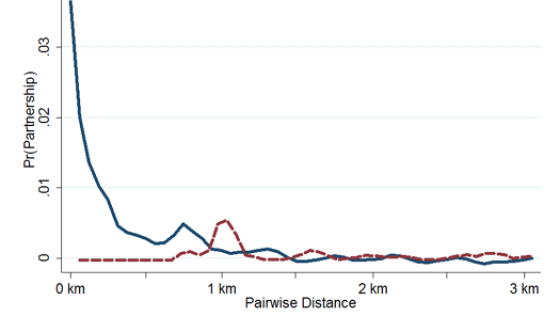In recent years, a growing body of research has highlighted the profound impact that early childhood circumstances can have on a wide range of later-life outcomes (e.g. Heckman 2006, Currie and Almond 2011, Karapakula and Heckman 2019). In particular, investing in public education at an early age is of importance if one wants to improve social mobility (Domnisoru et al. 2018). This has generated a significant academic and policy interest in the importance of early childhood education as a means to promote equal opportunities for children from diverse backgrounds.
Alongside investments in high-quality preschool programmes and parental education, the role of neighbourhoods in shaping educational trajectories has also been recognised. Beyond access to better schools and resources, factors such as community engagement, social networks, and safety can significantly impact a child’s development and prospects. In this column, we investigate the influence of neighbourhoods on early childhood development, drawing upon recent findings reported in the List et al. (2023) study on interventions by the Chicago Heights Early Childhood Center (CHECC).
Importance of neighbourhoods
Much of the evidence on the decisive role of neighbourhoods in human capital formation comes from studies examining the outcomes of individuals who relocate to wealthier neighbourhoods during their childhood (e.g. Chetty et al. 2016, Chetty and Hendren 2018). The evidence suggests that children that move to more affluent neighbourhoods at a young age tend to have better educational outcomes and higher incomes as adults. Furthermore, these gains diminish with the age at which the child moved to the better neighbourhood, emphasising the critical role of early exposure to beneficial neighbourhood environments. There is also evidence of the role of neighbourhood on outcomes using quasi-natural experiments (e.g. Deming et al. 2016, Dustmann et al. 2023). This research highlights the critical role of neighbourhoods in shaping lifetime outcomes and narrowing emerging income gaps.
The Chicago Heights Early Childhood Center
To gain insight into the intricate relationship between neighbourhoods and early childhood development, we turn our attention to the CHECC interventions in Chicago Heights, Illinois, in the US.
Chicago Heights is a neighbourhood on the South Side of Chicago, characterised by low-performing urban school districts and a predominantly African American and Hispanic population. The CHECC intervention aimed to support low-income families by offering two distinct programmes: a high-quality Pre-K (preschool) programme and a Parent Academy programme. These were designed to enhance both the cognitive skills of children (e.g. counting and spelling) as well as their non-cognitive skills (e.g. working memory and self-control).
The main goals of this large-scale randomised intervention were (1) to examine how investing in the cognitive and non-cognitive skills of low-income children 3 to 4 years of age affects their long-term outcomes; and (2) to evaluate the effectiveness of investing directly in children’s education versus indirectly through their parents. Participating families were randomly assigned to either the preschool programme or the Parent Academy parental education programme, or were placed in a control group.
This randomised intervention allowed researchers to assess the direct impact of the intervention on the outcomes of children who received them, while also examining whether neighbourhood exposure to treated families benefited children of untreated families. Since treated and untreated families lived in the same neighbourhood and belonged to the same community, the possibility of spillover effects seemed likely in the case of CHECC interventions.
Causal evidence of neighbourhood effects
The analysis of the CHECC intervention reveals compelling evidence of neighbourhood and spillover effects on children’s cognitive skills. Notably, List et al. (2023) report that children attending the Pre-K programme experience significant cognitive gains when surrounded by treated neighbours within a 0.5-kilometre radius. For each additional treated Pre-K neighbour, a child’s cognitive score increases by 0.058 standard deviations. These localised spillover effects diminish beyond a 1 kilometre distance, emphasising the importance of proximity and peer interactions.
The findings highlight the critical role of neighbourhood context in shaping early childhood development and suggest that the positive effects of high-quality early childhood education programmes can extend beyond beneficiary children to impact their peers residing nearby.
Surprisingly, the study finds no significant evidence of spillover effects on non-cognitive skills through either parents’ or children’s networks, despite both the Parent Academy and Pre-K interventions having sizeable direct effects on treated children. This suggests that while neighbourhood and spillover effects may have a specific influence on cognitive skills, other factors such as family and school resources, parenting practices, and individual characteristics may play a more prominent role in shaping non-cognitive skills.
Total impact of the CHECC interventions
In addition to documenting the positive spillover effects from the programmes delivered at CHECC, it is important to estimate the total impact of the intervention, accounting for these indirect effects. It is also valuable to disentangle the direct and indirect (spillover) effects of the intervention.
The total impact of the intervention on a child randomised into one of the CHECC programmes can be expressed as the sum of the direct treatment effect and the spillover effects. The total impact of being assigned to treatment (including both the direct and spillover effects) on a child’s standardised cognitive test scores is estimated to be 0.358 standard deviations. Notably, the spillover effects account for about 40% of the direct treatment effects and 28.5% of the overall effects on treated children. This finding implies that if a single child were treated in isolation, the average treatment effects would be approximately 60% of the estimated impacts when accounting for spillovers from other treated children. Focusing solely on the direct effects of the intervention on the treated population would neglect an important additional component – the indirect benefits that accrue due to spillovers.
Implications for policy
The implications of these findings are far-reaching, particularly for policymakers and educators seeking to improve early childhood education. Enhancing the quality of preschool programmes and promoting interactions among children in disadvantaged neighbourhoods can potentially amplify the positive spillover effects observed in the CHECC interventions. By considering the broader social context and peer dynamics, policymakers can design interventions that maximise cognitive skill formation during this critical period of development.
The results suggest that interventions that promote social interactions both within and between participants as well as with non-participants are likely to generate larger positive externalities on cognitive skills. Overall, the evidence from the CHECC interventions in Chicago Heights demonstrates the importance of considering (local) neighbourhood effects when designing early childhood education policies and interventions.
References
Chetty, R, N Hendren, and L F Katz (2016), “The effects of exposure to better neighborhoods on children: New evidence from the Moving to Opportunity experiment”, American Economic Review 106(4): 855–902.
Chetty, R, and N Hendren (2018), “The impacts of neighborhoods on intergenerational mobility I: Childhood exposure effects”, Quarterly Journal of Economics 133(3): 1107–62.
Currie, J, and D Almond (2011), “Human capital development before age five”, Handbook of Labor Economics 4: 1315–486.
Deming, D, S Ross, and S Billings (2016), “Neighbourhood spillovers in youth crime: Social interactions matter”, VoxEU.org, 11 July.
Domnisoru, C, L Taylor, and D Card (2018), “Invest in public education to increase intergenerational mobility”, VoxEU.org, 6 October.
Dustmann, C, M Mertz, and A Okatenko (2023), “Neighbourhood gangs, crime spillovers, and teenage motherhood”, VoxEU.org, 31 March.
Heckman, J (2006), “Skill formation and the economics of investing in disadvantaged children”, Science 312(5782): 1900–1902.
Karapakula, G, and J Heckman (2019), “Intergenerational benefits of high-quality early childhood education for underprivileged children: Evidence from the iconic Perry Preschool Project”, VoxEU.org, 23 August.
List, J, F Momeni, M Vlassopoulos, and Y Zenou (2023), “Neighborhood spillover effects of early childhood interventions”, CEPR Discussion Paper 18134.






